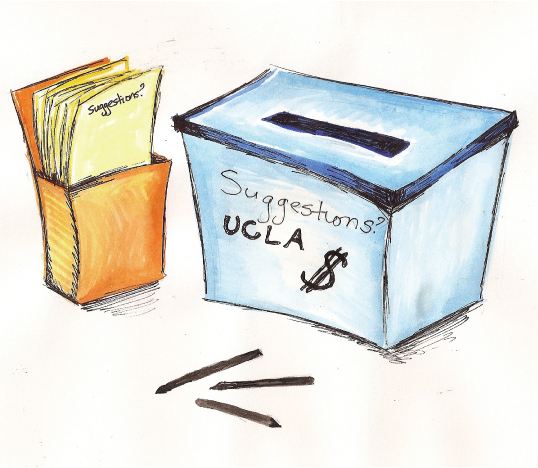When we ask why services are cut while fees are increased, students hear the same, tired refrain quarter after quarter: the California Legislature has cut funding again.
It is true that the state government is directly responsible for cutting the overall budget of the University of California by $813 million. It is equally true that our state representatives have neither treated UC students with any sort of compassion or moral responsibility, nor adequately funded the UC system. According to the UCLA Foundation, less than 13 percent of the University’s budget comes from the state’s general fund.
Thus, while state politicians must be aggressively lobbied, condemned and decried, it is no longer a sufficient excuse to point to Sacramento in explanation of further cuts to student services and further increases in student fees.
Instead, UCLA should begin a series of creative initiatives to increase funding. Three potentially budget-improving ideas are as follows:
Attracting and reaching out to other organizations for project-specific funding:
When students whose parents cannot or will not fund their higher education apply for school, they also apply for a myriad of grants and scholarships from any and all sources they can find. If the UC system is to maintain that its “parents” ““ the legislators that won’t fund it ““ are to blame, they should circumvent this problem by looking for systematic, outside funding.
The Getty Foundation, the philanthropic arm of the massive J. Paul Getty Trust that runs both the eponymous museum overlooking the campus and the Getty Villa in Malibu, lists “Access to Museum and Archival Collections” as one its four funding priorities. In fact, in its own words, “The Getty Foundation supports individuals and institutions committed to advancing the understanding and preservation of the visual arts locally and throughout the world.” That sounds tailor-made for our Arts Library problem.
By shifting some problematic funding issues to outside organizations and sources, UCLA would be able to avoid cutting services without imperiling its other priorities. Though the Getty Foundation example could be held back by policies that limit external funding, it is only one of an array of wealthy philanthropic forces in the Los Angeles area. If the school is able to impress the value of certain Westwood treasures upon these external trusts and funds, it stands to save large sums of money ““ saved resources it can then funnel into new projects.
Changing UCLA’s relationship with donors:
At UCLA, donor contributions to the UCLA Foundation totaled more than $481 million in the last fiscal year. The amount of donor-driven funding has increased the net assets of the foundation from $484 million in 1999 to the staggering $1.4 billion it currently controls. These efforts are critical and should be lauded.
However, donations almost always come with donor-specific strings attached that prevent the Chancellor or academic departments from utilizing them in a maximally efficient manner. Out of the aforementioned $481 million, only 15 percent falls into the category known as “Dean’s/Departmental Discretionary.” Over 50 percent is tied up for specific program and/or research based endeavors.
In an age of finicky state funding, the UCLA Foundation must make the effort to work with donors to reduce the number of donations that come with specific purposes. This may reduce the number of hidden graduate-level student lounges that receive new furniture. However, it will funnel more money into a general academic relief fund that should be set up in order to effectively dole out the potential millions of donor dollars to the most needy of campus divisions.
The first step in this transition should be the aggressive promotion of the Chancellor’s Greatest Needs and the College’s Greatest Needs funds. These discretionary funds funnel money into the UCLA Fund, which is in turn tasked with transferring funds to the campus.
Of course, it is more difficult to fund raise hundreds of millions of dollars if donors cannot see tangible results for their generosity. But the difficulty of ensuring that our campus can afford to provide top-notch education and student support is no excuse for not embarking on a bold new course of donor funding.
A third, derived point of budgetary salvation lies in increasing the budgetary independence of the Los Angeles campus from the fate of the greater UC system. Each campus is too tied to the fiscal well-being of the others. By focusing on the two earlier techniques, UCLA could seek assets that would be dependable, regardless of the condition of the state or anyone else.
It is time we move beyond simply complaining about politicians that have proven themselves irresponsible legislators. If current media coverage of the state assembly is any barometer of their passions, these folks are more likely to utter graphic details of their sexual liaisons with lobbyists into hot microphones than responsibly end California’s budget woes.
Instead, the UC ““ and UCLA in particular ““ should take the opportunity to emerge from this crisis as something other than a “top-tier public school.” In this era of ever-increasing competition in higher education, it is not time for hiring freezes and crippling budget cuts. It’s time UCLA attracts even more world-renowned faculty, starts exciting new majors and minors, and otherwise conducts business as it sees fit.
E-mail Makarechi at kmakarechi@media.ucla.edu. Send general comments to viewpoint@media.ucla.edu.
